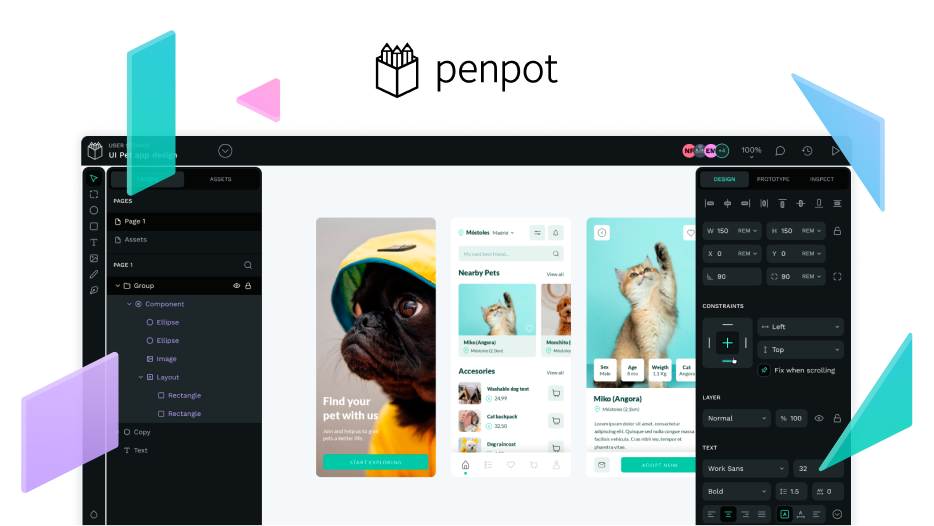I’m excited to share that since we launched general availability for Penpot in February, our community has grown by 66% to 400,000 strong. We are proud that more than 80,000 teams are now running on Penpot - including Mozilla, Blender, Fedora, Nextcloud and GitLab (as well as the usual suspects we share on our webpage). Our growth underscores the increased demand for an open source platform that prioritizes improving the working relationship between designers and developers.
Interestingly, we’ve seen self-hosted deployments double in that time. Over 50% of teams are opting to manage Penpot themselves on private clouds. More on that in a bit.
The whole team smiled with pride with this quote!
Why we’re growing so quickly together
It has become obvious that one major driver for this acceleration relies on how Penpot is improving existing workflows between designers and developers without adding more tools into the mix.
When we surveyed 30,000 Penpot users last year we found the split between designers and developers was nearly identical: 35% identified as designers and 34% as developers. While that hasn’t changed much in 2023, we’re experiencing a growth in the number of product/project managers (3% to 5%) and founders/VPs (4% to 6%).
Recently, I was having a conversation with someone in the business of cracking the future of design systems and they were clear about why Penpot was growing so fast.
Penpot is one of those unique tools that is conceived and built both by designers and developers, that’s your secret sauce!
Since you can’t fake that, one of the immediate consequences is that people keep inviting other team members to join larger teams.
And yet we owe so much to you, our community of incredible designers, developers and open source advocates! I’ve said this many times, Penpot is and will be as relevant and impactful as the community that stands behind it!
So it won’t come as a surprise that our roadmap is partly based on what you tell us you need or dream of. That is helping us push the boundaries of what is possible for design projects - including the launch of Flex Layout, inspect mode, and the unique ability to self host or enjoy a desktop app. So much more will be announced at our upcoming conference, Penpot Fest (in-person tickets are almost sold out but you can still join online!).
Contributions to our Templates & Libraries collection have doubled in just a couple of months with active community contributors now comfortably surpassing the 2k mark. What’s even more impressive, based on GitHub stars and forks, Penpot is a Top 1000 repo on GitHub (out of 130M+ GitHub repositories!).
There is so much energy and activity in this community that we are growing our community support and engineering teams to work with you more closely!
The team during the past FOSDEM conference in Brussels!
Penpot is growing even faster on private-cloud, why would you think that is?
I’ll share my own impression here. For the last five years, organizations have allowed and even encouraged employees to adopt SaaS products they’re most passionate about. Today, many of them are course correcting and taking back control of their data, security, and IP. This trend is causing more and more companies and organizations to deploy Penpot on private clouds.
In our case, we believe that this new trend is fueled by three coalescing factors:
- The undeniable perception of interface design as a key differentiating factor (and IP) in how the technology teams build engaging experiences for society, users and customers. Design is rapidly becoming one of the most important pieces of data to secure and control.
- The urgent need of cross-functional teams to have the right tools that bring the design process intimately close to development and devops, without adding yet another new tool to the already overwhelming collection of platforms, tools and plugins.
- The ubiquity of commoditized private clouds, easing the “SaaS behind our firewall” model. Both lower TCO (total cost of ownership) and IaC (Infrastructure as code) have cornered long-standing false dichotomies around public cloud and data-centers.
Born with an open source ethos means that Penpot had to be deployment agnostic, allowing any team to start with either SaaS, private cloud or even the Desktop app and switch between all three options while retaining full control over their projects and files. Our unapologetic stance for open standards makes choosing Penpot a future-proof bet.
We want to thank all of the 400,000 and growing designers and developers (and the growing ranks of product managers and founders) who have joined our community and contributed to making Penpot such a powerful tool. I can’t wait to share even greater news around Grid Layout, Advanced Components, the new UI and other exciting announcements at Penpot Fest!


